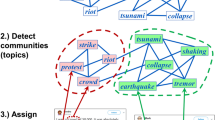Abstract
Twitter has become a significant means by which people communicate with the world and describe their current activities, opinions and status in short text snippets. Tweets can be analyzed automatically in order to derive much potential information such as, interesting topics, social influence, user’s communities, etc. Community extraction within social networks has been a focus of recent work in several areas. Different from the most community discovery methods focused on the relations between users, we aim to derive user’s communities based on common topics from user’s tweets. For instance, if two users always talk about politic in their tweets, thus they can be grouped in the same community which is related to politic topic. To achieve this goal, we propose a new approach called CETD: Community Extraction based on Topic-Driven-Model. This approach combines our proposed model used to detect topics of the user’s tweets based on a semantic taxonomy together with a community extraction method based on the hierarchical clustering technique. Our experimentation on the proposed approach shows the relevant of the users communities extracted based on their common topics and domains.
Access this chapter
Tax calculation will be finalised at checkout
Purchases are for personal use only
Preview
Unable to display preview. Download preview PDF.
Similar content being viewed by others
References
Hofmann, T.: Probabilistic latent semantic indexing. In: SIGIR, pp. 50–57 (1999)
Blei, D.M., Ng, A.Y., Jordan, M.I.: Latent dirichlet allocation. Journal of Machine Learning Research 3, 993–1022 (2003)
Fortunato, S.: Community detection in graphs. Physics Reports 486, 75–174 (2010)
Donetti, L., Martinez, M.A.M.: Detecting network communities. Journal of Statistical Mechanics: Theory and Experiment, 1–15 (2004)
Weng, J., Lim, E.P., Jiang, J., He, Q.: Twitterrank: finding topic-sensitive influential twitterers. In: WSDM, pp. 261–270 (2010)
Zhao, W.X., Jiang, J., Weng, J., He, J., Lim, E.-P., Yan, H., Li, X.: Comparing Twitter and Traditional Media Using Topic Models. In: Clough, P., Foley, C., Gurrin, C., Jones, G.J.F., Kraaij, W., Lee, H., Mudoch, V. (eds.) ECIR 2011. LNCS, vol. 6611, pp. 338–349. Springer, Heidelberg (2011)
Michelson, M., Macskassy, S.A.: Discovering users’ topics of interest on twitter: a first look. In: AND, pp. 73–80 (2010)
Hastie, T., Tibshirani, R., Friedman, J.H.: The Elements of Statistical Learning, Corrected edn. Springer (July 2003)
Du, H., Feldman, M.W., Li, S., Jin, X.: An algorithm for detecting community structure of social networks based on prior knowledge and modularity. Complexity 12(3), 53–60 (2007)
Johnson, E.L., Mehrotra, A., Nemhauser, G.L.: Min-cut clustering. Math. Program. 62, 133–151 (1993)
Newman, M.E.J.: Fast algorithm for detecting community structure in networks. Physical Review E 69, 66133 (2004)
Newman, M.E.J., Girvan, M.: Finding and evaluating community structure in networks. Phys. Rev. E 69(2), 026113 (2004)
Pathak, N., Delong, C., Erickson, K., Banerjee, A.: Social Topic Models for Community Extraction. Technical Report 08-005, Dept. Computer Science and Engineering, University of Minnesota (2008)
Girvan, M., Newman, M.E.J.: Community structure in social and biological networks. Proceedings of the National Academy of Sciences 99(12), 7821–7826 (2002)
Arenas, A., Duch, J., Fernandez, A., Gómez, S.: Size reduction of complex networks preserving modularity. CoRR abs/physics/0702015 (2007)
Author information
Authors and Affiliations
Editor information
Editors and Affiliations
Rights and permissions
Copyright information
© 2012 Springer-Verlag Berlin Heidelberg
About this paper
Cite this paper
Hannachi, L., Asfari, O., Benblidia, N., Bentayeb, F., Kabachi, N., Boussaid, O. (2012). Community Extraction Based on Topic-Driven-Model for Clustering Users Tweets. In: Zhou, S., Zhang, S., Karypis, G. (eds) Advanced Data Mining and Applications. ADMA 2012. Lecture Notes in Computer Science(), vol 7713. Springer, Berlin, Heidelberg. https://doi.org/10.1007/978-3-642-35527-1_4
Download citation
DOI: https://doi.org/10.1007/978-3-642-35527-1_4
Publisher Name: Springer, Berlin, Heidelberg
Print ISBN: 978-3-642-35526-4
Online ISBN: 978-3-642-35527-1
eBook Packages: Computer ScienceComputer Science (R0)




